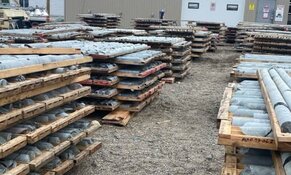The Gold Report: Investing in mining equities is a cyclical play. Are we at a point in the cycle for investors to return to mining equities?
Jamie Mackie: I think the gold mining stocks are at or near the bottom. Research from the Ned Davis Research Group shows that pessimism is extremely high—typically an indication that we are close to a bottom. From our perspective, that is the best time to position yourself. Once the market begins to turn, it will happen rapidly. Investors need to recognize value and get in reasonably early to avoid paying up later.
I compare the situation to being at a huge party; the party being the blue chip, dividend-paying sector. The party has been going on for quite a while, and it is hard to leave the party and sit in a room all alone. But that is what investors should do, spend time in the room alone, waiting for others to join them.
TGR: From a wealth-building perspective, how do mining equities fit in a world that is deleveraging?
JM: Your choice of the word deleveraging is interesting because I would say the world as a whole is not deleveraging.
True, U.S. households have begun to deleverage, which has been positive for the market. Corporations have been deleveraging for some time, but now, due to artificially low interest rates, they are beginning to take on more debt.
"People who want to protect against the ongoing depreciation of their savings need to have hard asset exposure."
Governments—except for those with austerity programs, like Greece, Ireland and Italy—have leveraged up massively. They are trying to make up for shortfalls in spending by corporations and consumers. Once governments ramp up spending, it is difficult for them to reduce expenditures later on. Governments are engaging in currency wars in an attempt to get their currencies down so their economies can compete globally. This is self-defeating. It inflates the money supply and puts downward pressure on the value of the currency.
Money printing is an insidious form of taxation on personal savings. People who want to protect against the ongoing depreciation of their savings need to have hard asset exposure. This process isn't stopping. Witness the March 20 decision by the U.S. Federal Reserve to continue with the Quantitative Easing program. Owning quality mining and energy companies or the commodities themselves offers protection against this.
TGR: As a private wealth manager, how much of a typical portfolio are you allotting to junior mining equities?
JM: Right now, in the 2–3% range, so fairly modest. Our focus is more on energy equities right now.
TGR: How do you counterbalance the risk junior mining equities represent?
JM: Our approach to offsetting the risk in junior mining focuses on senior blue-chip and dividend-paying equities. Although as things get more expensive we are taking money off the table. As price/earnings ratios for specific equities get out of our comfort range, we want safer opportunities.
People often ask whether bonds would be a good risk offset. We view the bond sector as the most expensive, inflated bubble ever. Apart from very short duration bonds, we are on the sidelines.
Perhaps a better way to offset the mining stock risk is with a larger portion of physical gold, perhaps a 70/30 ratio. Of that 30% in equities, 70% would be in larger-cap, Goldcorp Inc. (G:TSX; GG:NYSE)-type equities and the rest in smaller, well-capitalized juniors.
TGR: How do you mitigate risk before you take positions in junior mining equities?
JM: Management is number one. Does management have skin in the game? It is important that management be aligned with our interests.
TGR: Do you have a rule of thumb for ownership percentage?
JM: The bigger percentage of management's net worth, the better. Quality of the management team is really more important. Generally, if members of the management team are confident in their abilities and their projects, they will take significant positions.
TGR: What other factors help you mitigate risk?
JM: Time to production is important. The mining sector has something we call the "valley of death." A company has a great discovery, it takes six years to get into production; meanwhile, the stock plummets and the company cannot get financing. It is at 6–12 months before production that interest in the equity picks up again.
"Quality of the management team is really more important."
Then you look at the size of the ore body: Is the project big enough to attract the attention of an even higher-quality buyer? Is the project in a good jurisdiction? We have had what could be described as investment fatigue over political issues.
TGR: Investment fatigue is an interesting concept. Can you expand on it?
JM: When a government changes, the question becomes what one owns after the change. Egypt and Mali are two examples. Countries that follow British common law tend to be more stable from the point of view of jurisdiction and ownership. Russia is a country with a legal system quite different from British common law. It has been difficult to work in China from a property ownership point of view. Argentina's somewhat erratic government has been tough.
Other countries—Peru, Colombia and Chile, for example—have improved a lot.
TGR: Which small-cap mining equities have withstood the rigors of your due diligence?
JM: B2Gold Corp. (BTO:TSX; BGLPF:OTCQX) has a number of high-quality projects in decent jurisdictions. It is reasonably capitalized and can still raise money.
TGR: The B2Gold management team has built companies before, for example, Bema Gold, which was sold to Kinross Gold Corp (K:TSX; KGC:NYSE) for about $3.5 billion. Do you think management plans the same with B2Gold?
JM: Junior gold miners tend to be taken out by the bigger players. That is the ultimate liquidity event, and it would not surprise me if that was the plan. B2Gold could go to a Kinross or a Goldcorp, but for the time being I think it will stay independent.
TGR: What other companies are on your list?
JM: Detour Gold Corp. (DGC:TSX) has come through the valley of death and is on its way to production in about six months. Its capital risk is almost out of the way. The company is capitalized now and it looks quite cheap by most measures.
TGR: It published guidance of 350,000–400,000 ounces gold this year. Has Detour said what it plans to do with its cash flow?
JM: Management says it wants Detour to remain a single-purpose mining company. It does not want the headache of running more than one mine. I suppose its first step would be to pay down debt or perhaps issue a dividend.
TGR: It is a pretty impressive mine, located in a very stable jurisdiction in northeastern Ontario. Do you want to see a dividend?
JM: We would be delighted with a dividend. Dividends help the market value an equity differently. The idea is to start with a dividend program that allows a company to improve its business without taking on additional debt. When companies pay too much dividend, it hurts their stock.
TGR: Do you have any other names?
JM: There is IAMGOLD Corp. (IMG:TSX; IAG:NYSE). It has a great balance sheet and interesting projects. The company is trying to reposition itself in Canada, and the stock looks cheap because of those efforts and issues with a couple of their international projects. It has an almost 4% dividend now. We have been buying IAMGOLD.
TGR: Do you expect a price rebound or might future events keep the price down?
JM: I see way more upside in IAMGOLD than downside. Mali may not be the best jurisdiction, but the company has not had any interruptions there. The project generates a lot of cash.
"If you take a position in the junior mining sector, you have to be patient."
The issue in Mali is that the mine is not being expanded. IAMGOLD is a minority partner and does not really control its destiny. That is why the company is trying to reposition in Canada, where it controls 100%.
IAMGOLD has huge cash on the balance sheet. The company can move forward regardless of what the share price does. I think it should recover nicely; maybe not to $16/share, but to $11–12/share.
TGR: Does its exposure to Africa concern you?
JM: I think that is already discounted in the share price. Every day that passes, IAMGOLD is generating more cash.
Sanatana Resources Inc. (STA:TSX.V) has a property immediately adjacent to the Cote Lake in Ontario, Canada, property owned by IAMGOLD.
TGR: Was that the Trelawney acquisition?
JM: Sanatana was a partner with Trelawney on the Watershed project.
TGR: Is this play based on the idea that if Cote becomes a mine, Watershed will be developed?
JM: I would think so, yes.
TGR: Sanatana is a very small market-cap company doing exploration. The two questions are management and cash. What are your thoughts on both?
JM: I trust Sanatana's management. The team does what it says it will do. Peter Miles is a straightforward, honest guy. The team's technical capability is way beyond what you would anticipate in a small mining company. Buddy Doyle and Troy Gill are as good or better than you would find in any senior mining company.
The company has enough cash to keep going for a while, probably until it has NI 43-101 equivalent resources.
TGR: Is there enough cash to get the company through 2013?
JM: Yes, I think so.
TGR: What other companies would you like to discuss?
JM: We have followed Gold Standard Ventures Corp. (GSV:TSX.V; GSV:NYSE) through its ups and downs. The company seems to be on the road back up. It is in a highly prolific area in the Carlin Trend in Nevada. The company has had great results. The management team includes highly qualified technical people.
TGR: You visited the site. What were your impressions?
JM: Gold Standard's mine is next door to a number of great mines, which you can see from the property. That dramatically improves the likelihood of success. The company also has people very experienced with developing bigger mines in the area.
TGR: What did you think of the most recent drill results on the North Bullion Fault Zone?
JM: The company had some great results, 5–15 grams per ton on the target zone, and long length. This is not a tiny vein. This is a small company that would be attractive to a potential buyer.
TGR: I would like to change the subject to royalties. You are fairly bullish on precious metals royalties. The royalty model is inherently lower risk than actual mining, but royalty companies typically have a lot of exposure to movement in metals prices. What is your outlook for gold and silver prices for the rest of 2013?
JM: The party going on in the blue-chip, dividend-paying equities has resulted in an exodus from the mining sector and from the gold exchange-traded funds (ETFs) into stocks that generate income. The resulting sales of gold drove the gold price down.
On the other hand, physical gold is being bought by longer-term, stronger investors, i.e., the Chinese, Indian and other developing countries' governments, as well as individuals there. Private investors seeking insurance against currency debasement are buying the commodity, too. The ETF liquidations will cease at some point in the near future so in two to six months out we should see stronger gold prices, mid-$1,600/ounce (mid-$1,600/oz) or higher.
Silver is different. It has industrial uses, including some pretty healthy growth areas, such as electronics and water treatment. A lot of its uses are consumptive, and although there is some recycling, a lot of silver disappears. The ETF market has not been nearly as big on the silver side, and therefore not as disruptive as the gold ETFs. By year-end, silver could be, on a percentage basis, somewhat higher than today.
TGR: Could it push $35/oz by year-end?
JM: Silver is a volatile market. There will be spikes and retrenchments, but it could get there.
TGR: As of March 7, 2013, Franco-Nevada Corp. (FNV:TSX; FNV:NYSE) and Royal Gold Inc. (RGLD:NASDAQ; RGL:TSX) were trading at about 21 times their estimated 2013 cash flow. Does that suggest the larger royalty plays are overpriced or is there further upside?
JM: Franco-Nevada and Royal Gold deserve to be trading at some premium. However, at current levels I would probably be liquidating some percentage of my holdings to reinvest in the next tier down.
Silver Wheaton Corp. (SLW:TSX; SLW:NYSE) and Gold Royalties Corp. (TSX.V:GRO) are good examples. You would not transfer your entire Franco or Royal Gold positions down, but by taking a percentage off, you would see bigger upside on the smaller royalty companies.
TGR: Would you explain the difference between Silver Wheaton and Gold Royalties for our readers?
JM: Royalty companies get the pure price flow-through for the commodity without any of the production cost risk. Streaming companies effectively pay for capital development, which helps companies build out a mine or develop a project, then the streaming company takes, for example, the gold stream of a gold-copper play as Silver Wheaton recently did with Vale SA (VALE:NYSE). The streaming companies allocate an operating-cost component or production-cost component, so they have slightly more risk to commodity price variations than a pure royalty play.
TGR: How do royalty companies benefit from resource expansion on their mining properties?
JM: That is the big upside on royalty companies. In most of the projects they finance, they are buying into a royalty stream based on resources outlined in an NI 43-101.
Gold mining companies tend not to make capital expenditures to develop new reserves on their existing properties until they need to. Once a project is up and running smoothly, and the company has paid down some debt or proven that the economics are justifiable, it will drill up the surrounding land and get more reserves from that.
The streaming company gets huge upside on the pure future development of the mine. That is probably one of the reasons Franco and Royal are trading at such great multiples.
TGR: Smaller royalty players have entered the market, such as Premier Royalty Inc. (NSR:TSX) and Americas Bullion Royalty Corp. (AMB:TSX). Do they offer value or are they simply trying to piggyback on the success of the larger names?
JM: I am sure there is some mimicry of larger royalty companies. However, given the disarray in the mining sector and the dearth of capital on the junior side, there is an opportunity for smaller royalty companies to structure really attractive deals. There are just a handful of royalty companies. It is difficult for Franco, Royal Gold or Sandstorm Gold Ltd. (SSL:TSX.V) to take on these smaller projects. So there is lots of room for small entrepreneurial companies to do deals smaller than, say, $100 million.
TGR: In effect, if Franco finds a royalty play that could be profitable but does not meet its scale, the company could pass it on to Gold Royalties Corp., which already has an agreement in place with Franco to accommodate this.
JM: And the reverse, too. Gold Royalties could find a project that is too big and go to Franco for help on the funding.
TGR: What does Gold Royalties have in the pipeline that will produce growth for shareholders?
JM: The company has a number of projects. The Metanor Resources Inc. (MTO:TSX.V) project is onstream and producing cash flow. Its next projects are 18 to 24 months out, even up to three years out. Most of those projects are in Québec, Ontario and the Yukon.
TGR: Premier Royalty has a chart on its website showing that a royalty index consisting of Silver Wheaton, Franco-Nevada and Royal Gold outperformed the gold spot price by 54% from January 2008 through January 2013. Should investors expect similar gains over the next five years?
JM: These stories are evolving and benefiting from expansions in reserves and resources as the companies move projects forward. Royalty companies have the benefit of not having to pay for exploration or construction and are protected from operating cost escalation. The royalty companies could outperform the gold spot price.
TGR: What are your royalty holdings?
JM: Franco, obviously. We have owned Gold Royalties from its genesis. We own Silver Wheaton and are buying more. That one has a lot of upside; it is doing great deals in the right sectors, and has expanded into gold.
TGR: What advice would you give retail investors that they ought to hear, but might not want to hear?
JM: The stock market is massively fickle and the mining sector is in difficult times that could prevail for an extended period. In the long run, this is a self-correcting event. Mines will be delayed if things carry on as they are until demand returns, grows and outstrips supply.
Further decreases in the commodity price will damage equity values. Strong companies have the upper hand, and at some point, they will use it. They will find and purchase the best projects, although we have not seen much merger and acquisition activity lately.
I think even Goldcorp and Barrick Gold Corp. (ABX:TSX; ABX:NYSE) are shell-shocked. They have had huge cost escalation in projects and are looking to finish them before taking on others. That has been a real wet blanket on the junior mining sector.
The world keeps growing, along with demand for commodities. Currencies will continue to be debased. Inflation will begin to drive commodity prices higher.
The biggest question right now is when. Nobody has a good answer. The inflation numbers provided by governments are nowhere close to accurate. Good measures might be the cost of building a mine or the associated operating cost. If the costs were the prescribed inflation rate of 1.5%, the mining sector would not be having such huge cost overruns.
If you take a position in the junior mining sector, you have to be patient, although patience does not seem to be a virtue in the current market.
TGR: Jamie, thank you for your time and your insights.
Jamie Mackie has more than 33 years of experience in the investment banking and oil and gas industries to his position as senior vice president and senior investment adviser with Macquarie Private Wealth. He was founding partner and director of Finance of First Energy Capital Corp. and co-founder of Wilson Mackie and Company Inc. Prior to forming J.F. Mackie, which evolved into Mackie Research Capital Corp., he was an investment adviser with National Bank Financial Corp., previously First Marathon Securities. He worked at Suncor, Hudson Bay Oil and Gas, Dome Petroleum and Canadian Hunter on both the commercial and technical sides of the business. He holds degrees from the University of Calgary and a Master of Science in resource management from Yale University.
Want to read more Gold Report interviews like this? Sign up for our free e-newsletter, and you'll learn when new articles have been published. To see a list of recent interviews with industry analysts and commentators, visit our Streetwise Interviews page.
DISCLOSURE:
1) Brian Sylvester conducted this interview for The Gold Report and provides services to The Gold Report as an employee or as an independent contractor. He or his family own shares of the following companies mentioned in this interview: None.
2) The following companies mentioned in the interview are sponsors of The Gold Report: Goldcorp Inc., B2Gold Corp., Detour Gold Corp., Gold Standard Ventures Corp., Franco-Nevada Corp. and Gold Royalties Corp. Streetwise Reports does not accept stock in exchange for its services or as sponsorship payment.
3) Jamie Mackie: I or my family own shares of the following companies mentioned in this interview: Goldcorp Inc., Barrick Gold Corp., Gold Royalties Corp., Silver Wheaton Corp., IAMGOLD Corp. and Sanatana Resources Inc. I personally or my family am paid by the following companies mentioned in this interview: None. My company has a financial relationship with the following companies mentioned in this interview: Not to my knowledge. I was not paid by Streetwise Reports for participating in this interview. Comments and opinions expressed are my own comments and opinions. I had the opportunity to review the interview for accuracy as of the date of the interview and am responsible for the content of the interview.
4) Interviews are edited for clarity. Streetwise Reports does not make editorial comments or change experts' statements without their consent.
5) The interview does not constitute investment advice. Each reader is encouraged to consult with his or her individual financial professional and any action a reader takes as a result of information presented here is his or her own responsibility. By opening this page, each reader accepts and agrees to Streetwise Reports' terms of use and full legal disclaimer.
6) From time to time, Streetwise Reports LLC and its directors, officers, employees or members of their families, as well as persons interviewed for articles and interviews on the site, may have a long or short position in securities mentioned and may make purchases and/or sales of those securities in the open market or otherwise.









































